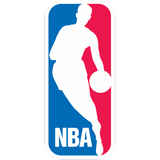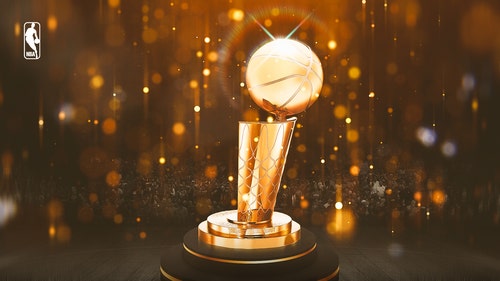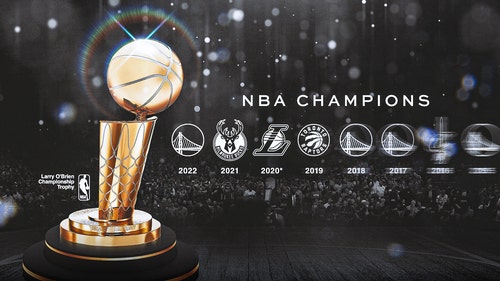
NBA All-Star Weekend 2022: Meet Mr. Moneyball
By Yaron Weitzman
FOX Sports NBA Writer
If Willy Wonka were a sports fan, his basement would look like Leo Klein's.
The floor is a checkerboard carpet in New York Knicks colors, with the team’s logo engraved on every dark block. The walls are covered with all sorts of classic photos and memorabilia.
Look, there’s a signed picture of Walt Frazier and Earl Monroe. And over there is one of the 360 signed "Sports Illustrated" covers Klein owns. And in front of you is a figurine of the Knicks’ 1973 championship starting lineup. And there's a display case featuring baseballs signed by every Cy Young winner in baseball history.

Leo Klein poses with his collection of "moneyballs" from every 3-point contest from the NBA's All-Star Weekend. (Photo courtesy of Nathaniel S. Butler)
"I’m not your usual fan," Klein, a 65-year-old attorney from Bergen County, New Jersey, told me over FaceTime. He’s a collector but not your usual collector, either. "Look at this," he said. "You can see how crazy I am."
He was pointing his phone to a wall, only you couldn’t see the white paint. It was a display rack, four rows high and 12 rows long. Resting in each was a Spalding basketball. Some looked like the classic ABA balls. One was purple and orange. One was silver and black.
Some fans collect baseball cards. Others collect autographs. Klein does all that, but around 2005, he decided to pursue a more eccentric collection, an oddity that most casual fans don’t even know exists.
Every year, the NBA puts on an All-Star Game. Starting in 1986, the Saturday night before every All-Star Game has featured a 3-point contest. As part of that 3-point contest, the league places a number of multicolored balls on each shooting rack, which represent two points per make. They’re called "moneyballs," and Klein is the only person known to own one from each year of the contest’s existence.
Of all his various collections, this is his crown jewel — and the one that required the most effort. In total, he has 35 moneyballs (there was no All-Star Weekend in 1999), including six that were used in the actual competition (all from the first six years).
The pursuit took more than 16 years. It began in 2005. Klein was in Denver for the NBA All-Star Game — he attends every year — and perusing the gift shop. A ball on display caught his eye. It was blue, yellow and white — a replica of the moneyball being used during that weekend’s 3-point contest. Klein liked the colors. He purchased the ball. At the next year’s All-Star Game, in Houston, a friend bought him another moneyball replica, this one red, gray and white. Now he had two.
"That’s when my moneyball search began," Klein said.

Klein's passionate pursuit of moneyballs included the placement of this ad to acquire balls from the 1986 and 1987 competitions, both won by Larry Bird.
Most moneyballs he was able to find with ease, thanks to the NBA’s decision to begin producing commemorative replicas. Getting his hands on one from last year was tricky — All-Star weekend took place in a bubble-like environment in Atlanta due to the COVID-19 pandemic — "but," Klein said, "I was able to get help from an NBA executive, who shall rename nameless."
The hardest balls to come by were from the contest’s first five years: 1986 to '90. Back then, according to Klein, they were produced only for the event.
He was able to corral balls from the 1988, ‘89 and ‘90 through memorabilia auctions, ads in "Sports Collectors Digest" and working the phones. But the moneyballs from 1986 and 1987 eluded him.

The moneyball is always the last ball in the rack, and it carries extra value for 3-point contestants, such as Kyrie Irving here in 2015. (Photo by Noah Graham/NBAE via Getty Images)
Klein tried everything, even tracking down Rick Welts, a longtime NBA executive who is credited with creating the contest, at the funeral of former NBA commissioner David Stern, which Klein was able to attend thanks to a relationship he’d developed with Earl Monroe.
"And I sort of cornered Welts," Klein told me. "And said, ‘Rick, please, you’ve got to help me.’" Klein pulled out his phone and showed Welts a picture of his collection. "And he goes, ‘Wow, OK, what do you want?’ and I said, ‘I only have two questions: Do you have any balls, and do you know where I can find them?"
Welts was unable to help, so Klein got creative. He knew Larry Bird had won the contest in ‘86 and '87. Maybe if he searched for autographed Bird basketballs, he’d stumble onto a moneyball from one of those seasons?
This past July, while sitting at his computer and watching TV, Klein did exactly that. He ended up on the website of a small antique jewelry shop in Gardena, California. Buried in the middle, amidst rows of vases and crystals, was a red, white and blue basketball that, according to the listing, was signed by Bird.
Klein called the owner, got some pictures and matched those up with pictures of the ball from the 1987 contest — specifically its imprints, which could be spotted if he zoomed in. The shop owner told Klein that he bought the ball from a former executive at Sheraton — which Klein learned, after spotting the company’s name on a ball trolley in photos from the 1987 shootout, was the sponsor for that year’s contest.
That was all he needed to hear. He declined to say how much he spent, but that day, he found a friend within driving distance of Gardena and arranged for the ball to be picked up.
Then, in October, he was able to complete his set. A former equipment staffer for the Dallas Mavericks had sold some memorabilia at auction a year earlier — a sale that included a moneyball from the inaugural 3-point contest, which took place in Dallas. Klein made some calls and learned that the ball had been sold to a collector. He called him, and the collector, Klein said, was happy to sell him the ball.

The 3-point contest in 1990 was a star-studded field, featuring both Larry Bird and Michael Jordan. Also competing were (back row, from left) Reggie Miller, Jon Sundvold, Mark Price and Craig Hodges, along with (front row, center) Bobby Hansen and Craig Ehlo. (Photo by Nathaniel S.Butler/NBAE via Getty Images)
"He told me he knows what it is to collect and complete a set," Klein said. He was ecstatic. "You have to understand," Klein said. "I wasn't sure the ball even existed."
Prior to this season, the NBA switched official ball providers, with Wilson replacing Spalding. That change brought an end to Klein’s chase and put a bow on his collection. He accomplished his goal.
"They’re timepieces," Klein said. "They show you how the game evolves, how things change. They’re like photos. They preserve a moment in time."
He pointed the phone’s camera to the 1987 ball, autographed by Bird.
"I mean, look at this," he said, his voice climbing high with excitement. "I wouldn't give this away for 10 grand."
Yaron Weitzman is an NBA writer for FOX Sports and the author of "Tanking to the Top: The Philadelphia 76ers and the Most Audacious Process in the History of Professional Sports." Follow him on Twitter @YaronWeitzman.










